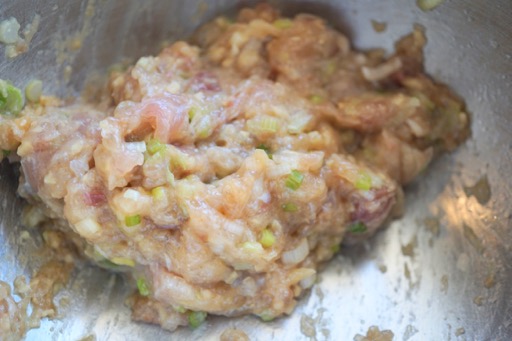I made clear soup with mackerel meatballs, silken tofu and sliced scallion and added (frozen) yuzu zests just before serving.
Ingredients: (the amount is for two servings from the recipe I saw on line as a reference. The amount of mackerel I used was less than indicated in the recipe and, as usual, I did not precisely measure quantities. I also made minor modification.)
For the meatballs:
Mackerel, skimmed from backbone or filet with skin removed (160 gram or 5.6oz)
Salt, scant pinch
Sake or water 1 tbs
Miso and potato starch, 1/2 tbs each
Sesame oil, 1 tsp
Scallion, 1/2 finely chopped
Ginger root, skin removed and finely chopped, 1/2 tsp
For broth:
Japanese dashi broth, 3 cups (I used my usual "dashi pack" with bonito and kelp).
Light colored soy sauce, 1 tbs
Scallion, 1 stalk, thinly sliced on bias.
Silken tofu 1/4 block, cut into bite-size cubes
Yuzu zest (I used frozen ones)
Directions:
Using a chef's knife, mince the fish meat and mix in all the ingredients for the meatballs.
Mix well (see below). Adjust the liquid (either sake or water, I used sake) to make the consistency (not too firm and no too soft, it has to stay together when cooked in broth but you want it to make soft tender meatball).
Bring the broth to a gentle simmer and using two teaspoons first dipped in the broth to prevent sticking, make small balls (or quenelles) and gently drop it into the broth (below) and let it cook through (a few minutes).
When the meatballs are cooked, season the broth with light colored soy sauce. Taste and if you need more saltiness, either add more soy sauce or add salt if you do not want the broth to become too dark.
Add the tofu and the scallion. When the tofu warms up, serve in a bowl and garnish with the Yuzu zest.
For a starch side, I served a variation of butter and soy sauce rice. Since I only had cold leftover rice, I first melted butter in a non-stick frying pan, added the cold rice and fried it to warm it up. Then I added a small amount of soy sauce to finish. I garnished with nori.
I have posted that the substitute for "Nanohana" 菜の花 in the U.S. is either rapini or broccolini. I like rapini since it has a slight bitterness similar to Nanohana. To complete the spring theme (color-wise) I added the bright yellow of scrambled eggs seasoned with sugar and salt. The rapini was blanched, cooled in cold water, drained and dressed with a mixture of Japanese mustard, sugar and soy sauce or "Karashi-jouyu" 辛子醤油.
Of course, we had to test some of the mackerel in miso. I served it with blanched broccoli for color.
Although I served this with only a small amount of rice, this was quite filling for us. The soup and fish balls were really good with ginger and yuzu flavors coming through but not at all "fishy".




































